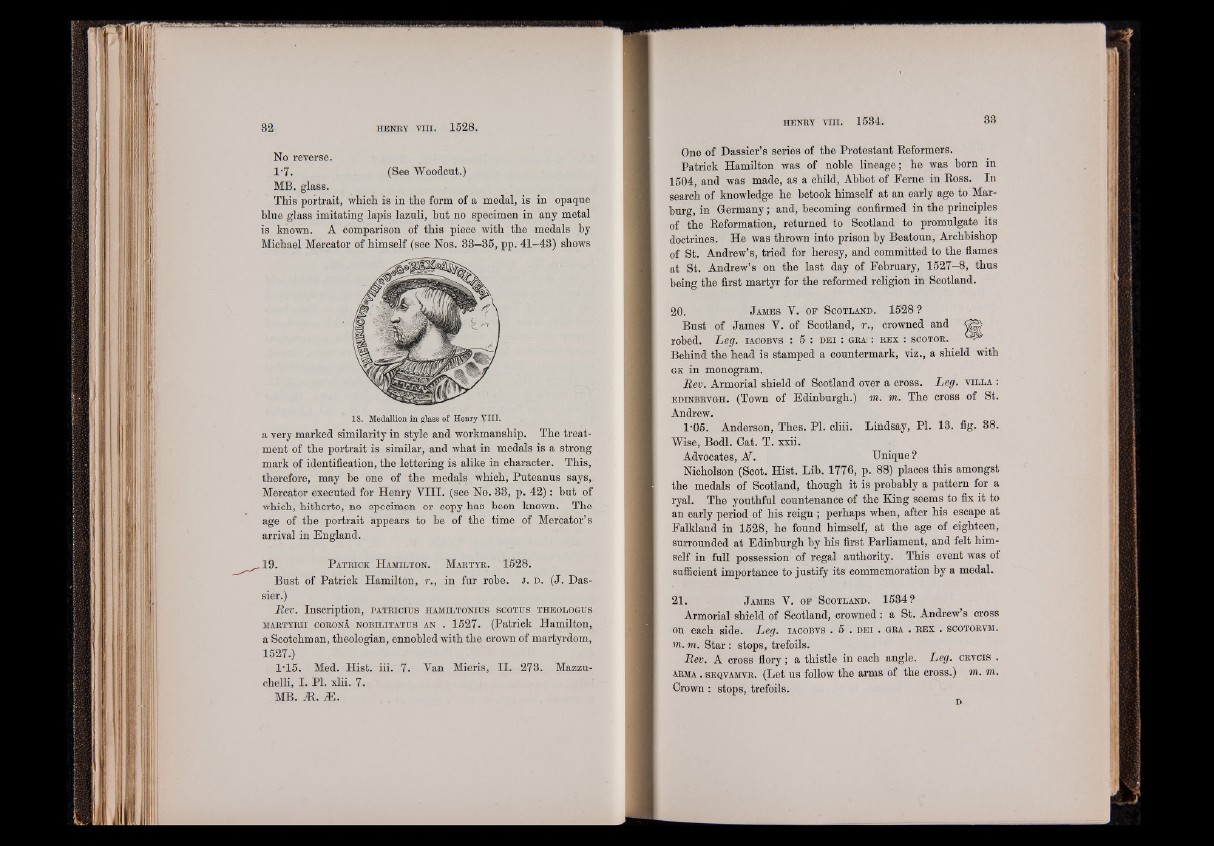
No reverse.
l -7. (See Woodcut.)
MB. glass.
This portrait, which is in the form of a medal, is in opaque
blue glass imitating lapis lazuli, but no specimen in any metal
is known. A comparison of this piece with the medals by
Michael Mercator of himself (see Nos. 33—35, pp. 41-43) shows
18. Medallion in glass of Henry pO ji
a very marked similarity in style and workmanship. The treatment
of the portrait is similar, and what in medals is a strong
mark of identification, the lettering is alike in character. This,
therefore, may be one of the medals which, Puteanus says,.
Mercator executed for Henry VIII. (see No. 33, p. 42): but of
which, hitherto, no specimen or copy has been known. The
age of the portrait appears to be of the time of Mercator’s
arrival in England.
19. P a t r i c k H a m i l t o n . M a r t y r . 1528.
Bust of Patrick Hamilton, r., in fur robe. j . d . (J. Das-
sier.)
Rev. Inscription, p a t r i c i u s h a m i l t o n i u s s c o t u s t h e o l o g u s
m a r t y r i i c o r o n a n o b i l i t a t u s a n . 1527. (Patrick Hamilton,
a Scotchman, theologian, ennobled with the crown of martyrdom,
1527.)
1‘15. Med. Hist. iii. 7. Van Mieris, II. 273. Mazzu-
chelli, I. PI. xlii. 7.
MB. At. M.
One of Dassier’s series of the Protestant Reformers.
Patrick Hamilton was of noble lineage; he was born in
1504, and was made, as a child, Abbot of Feme in Ross. In
search of knowledge he betook himself at an early age to Marburg,
in Germany; and, becoming confirmed in the principles
of the Reformation, returned to Scotland to promulgate its
doctrines. He was thrown into prison by Beatoun, Archbishop
of St. Andrew’s, tried for heresy, and committed to the flames
at St. Andrew’s on the last day of February, 1527-8, thus
being the first martyr for the reformed religion in Scotland.
20. J a m e s V. o p S c o t l a n d . 1528 ?
Bust of James V. of Scotland, r., crowned and
robed. Leg. i a c o b v s : 5 : d e i : g r a - : r e x : s o o t o r .
Behind the head is stamped a countermark, viz., a shield with
gk in monogram.
Rev. Armorial shield of Scotland over a cross. Leg. v i l l a :
e d i n b r v g h . (Town of Edinburgh.) in. m. The cross of St.
Andrew.
1’05. Anderson, Thes. PI. cliii. Lindsay, PI. 13. fig. 38.
Wise, Bodl. Cat. T. xxii.
Advocates, Ar. Unique ?
Nicholson (Scot. Hist. Lib. 1776, p. 88) places this amongst
the medals of Scotland, though it is probably a pattern for a
ryal. The youthful countenance of the Bang seems to fix it to
an early period of his reign ; perhaps when, after his escape at
Falkland in 1528, he found himself, at the age of eighteen,
surrounded at Edinburgh by his first Parliament, and felt himself
in full possession of regal authority. This event was of
suflicient importance to justify its commemoration by a medal.
21. J a m e s V. o p S c o t l a n d . 1534?
Armorial shield of Scotland, crowned : a St. Andrew’s cross
on each side. Leg. ia c o b v s . 5 . d e i . g r a . r e x . s c o t o r v m .
m. rn. Sta r: stops, trefoils.
Rev. A cross flory; a thistle in each angle. Leg. c r v c i s .
a rm a . s e q v am v r . (Let us follow the arms of the cross.) m. m.
Crown : stops, trefoils.
D